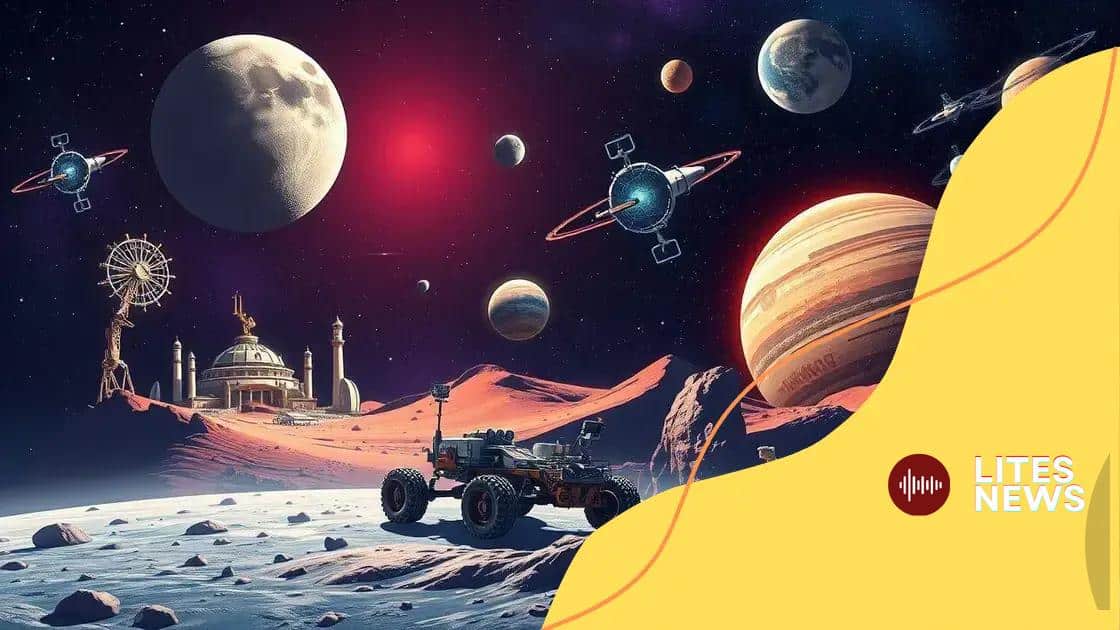Space exploration missions planned for 2025: what to expect

Space exploration missions planned for 2025 aim to enhance scientific knowledge, promote international collaboration, and drive technological advancements, setting the stage for future discoveries beyond Earth.
Space exploration missions planned for 2025 mark an exciting era for humanity. With ambitious goals set by various space agencies, there’s so much to look forward to. Are you ready to dive into what’s coming next?
Overview of upcoming missions in 2025
2025 promises to be a landmark year for space exploration. As international space agencies gear up for various missions, excitement builds around what these endeavors mean for the future of human and robotic exploration.
Key Missions to Look Out For
Several missions are in the pipeline, each with distinct goals. Here are some that stand out:
- NASA’s Artemis II: A crewed mission aimed at orbiting the Moon, paving the way for future lunar exploration.
- ESA’s Jupiter Icy Moons Explorer (JUICE): This mission will study Jupiter’s moons to search for potential habitability.
- Indian Space Research Organisation’s Gaganyaan: India’s first crewed mission that will usher in a new era for the nation’s space capabilities.
These missions represent just a fraction of the ongoing efforts to push the boundaries of what we know about our universe. As nations collaborate and compete in space exploration, the quest for knowledge intensifies.
Collaborations and Innovations
Collaboration between nations has become essential. The partnerships formed for various missions will undoubtedly lead to groundbreaking innovations. These innovations are not only technological; they also help broaden our understanding of the cosmos.
Additionally, advancements in propulsion technology and spacecraft design will allow for longer and more efficient missions. Investing in research today ensures that the upcoming missions will achieve extraordinary milestones in our quest for knowledge.
As we gear up for 2025, the landscape of space exploration will surely evolve. Each mission stands as a testament to human ingenuity and the relentless drive to explore beyond our planet.
Key players in space exploration
In the realm of space exploration, several key players lead the charge. From government space agencies to private enterprises, the collaboration and competition between them shape the future of space science.
Government Space Agencies
Many countries have established their own space agencies dedicated to exploring the universe. Some of the most prominent include:
- NASA: The United States’ space agency, known for its ambitious missions to the Moon and Mars.
- ESA: The European Space Agency conducts cooperative programs across Europe and beyond, focusing on a wide array of space research.
- Roscosmos: Russia’s governmental body responsible for space science, known for its long history in space exploration.
These agencies not only push the boundaries of human knowledge but also collaborate on international missions, fostering a sense of global unity.
Private Companies
Private companies have become increasingly influential in space exploration. Through innovation and competition, they are changing the landscape of how we approach space travel and research. Some notable players include:
- SpaceX: Led by Elon Musk, SpaceX has revolutionized space travel with its reusable rockets and ambitious plans for Mars colonization.
- Blue Origin: Founded by Jeff Bezos, Blue Origin focuses on reusable launch systems and aims to make space travel more accessible.
- Virgin Galactic: Known for its suborbital flights, Virgin Galactic aims to open space tourism to the general public.
The unique approaches of these private companies complement governmental efforts, often leading to rapid advancements in technology and exploration capabilities. As these players work both independently and together, they shape the future of space exploration in unprecedented ways.
Objectives and goals for 2025 missions

The objectives and goals for 2025 missions are ambitious and varied, reflecting humanity’s desire to explore further than ever before. Each mission aims to answer critical questions about our universe and our place within it.
Exploration of New Frontiers
Many missions are set to explore areas of space that have remained largely uncharted. For example, NASA’s Artemis II will pave the way for a sustainable human presence on the Moon. This mission is not just about lunar exploration; it’s about establishing a base for future Mars missions.
- Studying Mars: Missions like Mars Sample Return will aim to bring back soil samples to Earth, potentially revealing clues about past life.
- Jupiter’s Moons: ESA’s JUICE mission will investigate Europa and Ganymede, focusing on their potential to support life.
- Exoplanet Research: Upcoming telescopes will try to identify Earth-like planets in distant star systems.
Through these exploratory missions, scientists hope to gather data that could change our understanding of life beyond Earth.
Technological Advancements
The 2025 missions also emphasize the importance of technology in space exploration. New technologies are being developed to improve the safety and efficiency of space travel. This includes advancements in propulsion systems that will allow for quicker travel times.
Additionally, autonomous robots and AI systems are being integrated into missions. These technologies enable better navigation and data collection, making exploration more efficient. For instance, rovers and drones can operate in real-time, making decisions based on new data as they gather it.
The goals of space missions in 2025 are not solely focused on physical exploration. They also aim to inspire the next generation of scientists and engineers. By showcasing advancements and discoveries, agencies hope to spark interest and encourage future innovators to contribute to the field of space exploration.
Technological advancements expected
The technological advancements expected in space exploration for 2025 are set to revolutionize how missions are conducted. As new technologies emerge, they enhance our ability to explore and understand the universe.
Enhanced Propulsion Systems
One of the key areas of focus is propulsion technology. Advanced propulsion systems are being developed to allow spacecraft to travel faster and more efficiently. These enhancements will enable missions to cover larger distances within shorter time frames.
- Ionic thrusters: These offer efficient, long-duration thrust, making them suitable for deep space travel.
- Solar sails: Utilizing sunlight for propulsion, they represent a breakthrough in energy use for space vehicles.
- Nuclear thermal propulsion: This technology could significantly shorten travel time to distant planets like Mars.
These innovations are crucial for future exploration and could make missions more feasible and cost-effective.
Autonomous Systems in Spacecraft
Another exciting development is the integration of autonomous systems into spacecraft. These systems allow for greater independence from ground control. As missions become more complex, autonomous technology enables spacecraft to make real-time decisions based on new data.
For instance, rovers on Mars can now navigate uneven terrain without waiting for commands from Earth. This capability will enhance mission efficiency and safety, allowing for extended exploration.
The use of artificial intelligence is also on the rise. AI can analyze large datasets quickly, identifying patterns that human analysts might miss. As we collect more data from distant planets and moons, AI will be key in interpreting that information.
The advancements in technology, like propulsion systems and autonomous spacecraft, are paving the way for a new era of space exploration. These innovations will not only make it possible to achieve greater heights in exploration but also inspire the next generation of explorers and scientists.
Impact of these missions on future exploration
The impact of these missions on future exploration will be profound, shaping how we understand our universe and our place in it. Each mission not only brings new data but also opens doors to further advancements in technology and international collaboration.
Advancements in Scientific Knowledge
As space agencies send missions to the Moon, Mars, and beyond, they gather crucial data. This data helps answer fundamental questions about planetary formation, the potential for life, and the history of our solar system.
- Understanding Mars: New findings from Mars missions could reveal if life ever existed on the planet, changing our perspective on habitability.
- Lunar Research: Studies conducted near the Moon’s south pole will help scientists understand cosmic events and gather resources for future missions.
- Exploring Icy Moons: Missions targeting Jupiter’s Europa and Saturn’s Enceladus will examine subsurface oceans, fueling the search for extraterrestrial life.
This flow of new information will enhance humanity’s grasp of complex scientific concepts.
International Collaboration
Another significant impact of upcoming missions will be the strengthening of international partnerships in space exploration. As various countries participate in collaborative missions, they share resources and expertise. This collaboration fosters a sense of unity and shared purpose.
For example, the Artemis program not only involves NASA but also includes international space agencies like ESA and JAXA. Working together, these agencies aim to establish a sustainable human presence on the Moon, which will serve as a stepping stone for future Mars missions.
As global challenges arise, the cooperative spirit in space exploration can serve as a model for addressing issues on Earth. By pooling knowledge and technology, nations can achieve more than they might alone.
The ongoing missions will set the stage for future exploration by driving innovation, enriching our scientific knowledge, and promoting global collaboration. Each mission builds on the last and propels humanity toward a deeper understanding of the cosmos.
The exploration missions planned for 2025 are set to transform our understanding of the universe. These missions will not only enhance scientific knowledge but also foster international collaboration. By pushing the boundaries of technology and innovation, we are entering a new era of space discovery. The partnerships formed during this time will inspire future generations and ensure that many more discoveries are yet to come. As we look forward, the excitement for what lies beyond our planet grows, reflecting our collective aspiration to explore the unknown.
FAQ – Frequently Asked Questions about Space Exploration Missions Planned for 2025
What are the main objectives of the 2025 space missions?
The main objectives include advancing scientific knowledge, exploring new frontiers, and establishing a sustainable human presence on the Moon and Mars.
How will international cooperation affect these missions?
International cooperation will enhance resource sharing, improve mission effectiveness, and foster a collaborative spirit among space-faring nations.
What technological advancements are expected in 2025?
Expected advancements include improved propulsion systems, autonomous spacecraft capabilities, and enhanced AI technologies for data analysis.
How will these missions inspire future generations?
These missions will serve as a source of inspiration, encouraging young people to pursue careers in science, technology, engineering, and mathematics (STEM).





